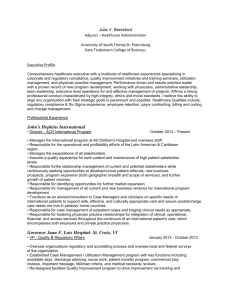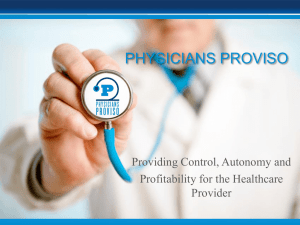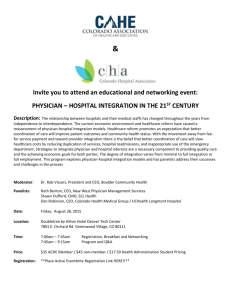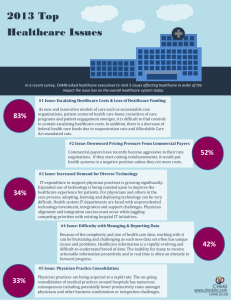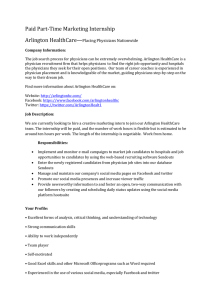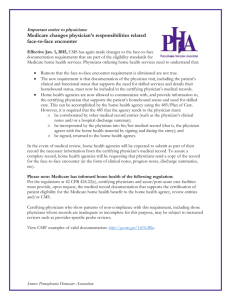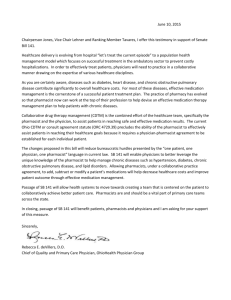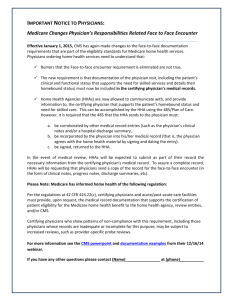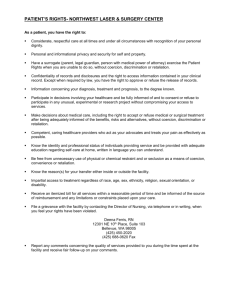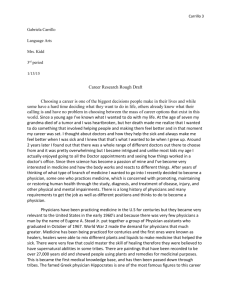Healthcare in the Age of the Consumer
advertisement
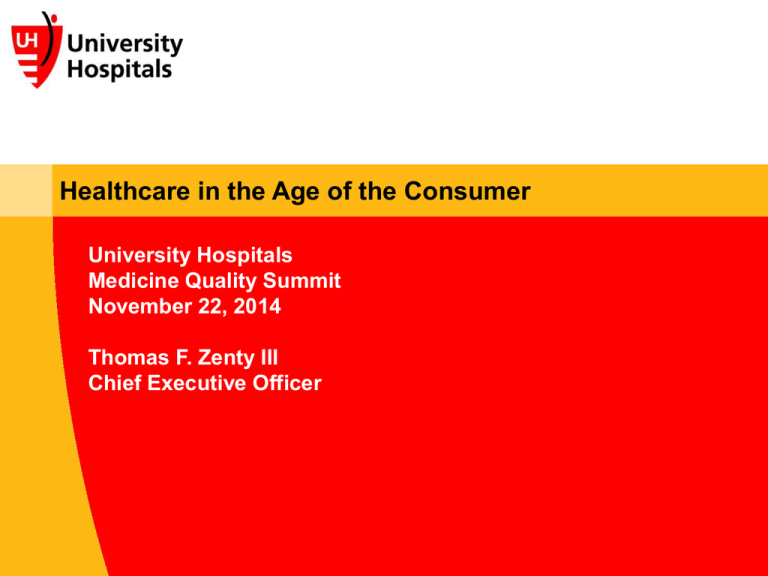
Healthcare in the Age of the Consumer University Hospitals Medicine Quality Summit November 22, 2014 Thomas F. Zenty III Chief Executive Officer Agenda • How we got here • Importance of social media • Increasing demands on physicians • Opportunity in a consumer directed market • Dialogue 4/13/2015 2 Healthcare Spending 2012 20% 33% 6% 4% 10% 3% 4/13/2015 3% 21% 3 4/13/2015 4 Enrollment in High-Deductible Plans has Tripled since 2009 4/13/2015 5 Growth in High Deductible Health Plans 2014 Data by State 1. Illinois 2. Texas 3. Ohio 4. Pennsylvania 5. Michigan 4/13/2015 Total Enrollment in High Deductible Health Plans 1,055,000 1,043,000 803,000 692,000 691,000 6 Consumer Paradigm: “Doctor, the patient will see you now” 4/13/2015 7 Change Imperatives • Increased competition • Increased cost-sharing • Consumerism and retail markets • Public and private exchanges • Social media and UH’s reputation • Medicare growth 4/13/2015 8 Change Imperatives • Give me choice and control • Keep it simple and personalized • Make it convenient, accessible and available • High quality is assumed 4/13/2015 9 Change Imperatives • Support sustainable growth • Improve efficiency and consistency • Increase affordability • Leverage technology investments to improve speed to market and member experience 4/13/2015 10 New Entrants Into Healthcare 4/13/2015 11 Importance of Social Media • Global penetration of cellular coverage is 92% as of 2013; – 25% of US smartphones have healthcare apps • 70% trust medical information shared by others on social media • 40% likely to share information about their health on social media • 50% use social media for health care decisions • More than 50% of health care reporters look to social media for information and medical experts 4/13/2015 12 2005 – Pope Benedict Inauguration 4/13/2015 13 2013 – Pope Francis Inauguration 4/13/2015 14 Importance of Social Media Consumers feel social media was built by consumers and trust the medium more than others 4/13/2015 15 ZocDoc – One example 4/13/2015 16 Increased Transparency – Univ. of Utah • Internal website shows all patient comments – both negative and positive – when patients search for a doctor 4/13/2015 17 UH Access Department • Central scheduling and physician referral services handle ~ 900,000 calls / year – 50% of calls lead to scheduled appointments – 30% of calls related to what it will cost the patient • Copay, deductible, facility fee, etc. • Physician A vs Physician B • Facility A vs Facility B 4/13/2015 18 UH Access Department • New system (Clear Quote) predicts what patients out of pocket costs will be – Expected go live Q1 2015 – Takes into account physician behavior 4/13/2015 19 UH Access Department Community standard is same day appointment 4/13/2015 20 Emergence of Virtual Health • Virtual doctor-patient video consultations to grow 65% by 2018 • Expected revenue from video consultations: – 2013 - $100 Million – 2018 - $13.7 Billion • Mayo Clinic goal - serve 200 million people • Kaiser of Northern California predicts by 2016 they will have more virtual visits than in-person visits 4/13/2015 21 Emergence of Big Data • As an industry we are now beginning to use data to anticipate what consumers want and expect • Big data leads to: – – – – New research and treatments based on clinical intelligence Identification of best practices Reduction in inconsistencies among providers Predictive models to forecast patient behavior and provide preventive care – Better patient experience by targeting what patients want and when they want it – Cost savings from more efficient use of information 4/13/2015 22 Early Results of Reform Higher Quality Can Coincide with Lower Cost National results since 2010: – – – – – – – Early elective deliveries down by two-thirds Ventilator-associated pneumonia down by > than half Pressure ulcers down by 26% Patient falls down by 15% Medicare 30-day readmissions down by 8% Prevented 560,000 hospital-acquired conditions Saved 15,000 lives 4/13/2015 23 Early Results of Reform Higher Quality Can Coincide with Lower Cost UH results since 2010: – – – – – – 4/13/2015 Early elective deliveries down by 72% Ventilator-associated pneumonia down by 50% Pressure ulcers down by 49% Patient falls down by 52% Medicare 30-day readmissions down by 19% Prevented 149 hospital-acquired conditions 24 Increasing Demands on Physicians • Improve quality • Manage costs • Coordinate care • Improve productivity • Shift from volume to value • Respond to regulatory change • Adopt culture of shared authority • Engage patient as partner • EMR • Social media interactions with patients • Stay current 4/13/2015 25 The Challenge of Change for Physicians 4/13/2015 26 From Challenge to Opportunity in Consumer Directed Healthcare • Investing in / improving EMR • How long people are willing to wait • How do patients want to communicate • Use of apps 4/13/2015 27 What Will You Wait For? WEEKS MONTHS Accessing a Doctor DAYS Online Shipping Opening a Credit Card HOURS Opening a Bank Account Booking a Flight via Phone MINUTES Booking a Flight Online Taxi/Car 28 Patients Prefer Near-Term Appointments 4/13/2015 29 How Do Patients Want to Communicate • 62% want to communicate via email with physician • 65% want appointment reminders via email • 25% want to schedule appointments online • 76% are willing to go online to view test results • 10% want interactions solely through an app on their phone Health systems who don’t adapt will continue to struggle to build a strong consumer experience 4/13/2015 30 Clinical Integration • Higher quality • Continuity of care • Bi-directional information flow • More efficient processes • Cost reduction for all stakeholders • Positioned for lower risk management • Customer facing • “Doctor, the patient will see you now” 4/13/2015 31 Primary Care Institute Four main goals: 1. Help physicians deliver excellent outcomes and patient experience 2. Increase physician engagement and satisfaction with UH 3. Encourage innovation in developing new care models 4. Improve value 4/13/2015 32 Primary Care Institute Deliverables • Discover new models of patient management and clinical care • Improve communication • Adopt care models that enhance experience and outcomes • Foster growth in care services that MDs want to deliver • Create opportunities for MDs to partner with community 4/13/2015 33 What PCP’s Can do to Help • Be open to learning, discovery and innovation • Participate and share insights • Trust that future incentives will lead to better health outcomes 4/13/2015 34 2/08/2010 4/13/2015 University Hospitals 35
